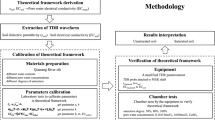Abstract
The permafrost with the highest altitude and largest area in the mid and low latitude is located in the Qinghai-Tibet Plateau. As most frozen soils contain ice particles which are very sensitive to temperature and other external parameters, thus influencing the stability of the embankment in permafrost regions, it is very important to develop techniques to prevent damages to railway embankments due to thaw settlement. In this paper, the electrical capacitance sensors are designed to study the freezing front movement in a vessel and ice movement in water, which is the first step to apply the ECT system to the study of frozen soil. Two sensor arrangements are put into use. First, the traditional closed electrode sensors are put into use. In this arrangement, the electrodes are attached to the outside of the pipe or vessel, and the cross-sectional distribution of ice and water could be reconstructed from the capacitances measured. Also, the ice moving track at the cross section could be reflected thoroughly. Since the traditional closed electrode sensors can not meet the needs of measuring the ice freezing front movement, a new electrode sensors structure, that is, the unclosed electrode sensors are designed to satisfy the specific test of frozen soil. In this arrangement, several pairs of electrodes are arranged along the height of the vessel. A sudden decrease in the measured capacitance is observed when the freezing front advances past the electrodes. Therefore, according to the capacitance variation, the ice movement can be reflected. In summary, electrical capacitance tomography has the advantages of being non-intrusive. With different electrode sensor arrangement, ice movement and ice freezing front can be obtained. The electrical capacitance sensor system can be applied to investigate the complicated phenomena in frozen soil.
Similar content being viewed by others
References
Guodong Cheng, (2005), A Roadbed Cooling Approach for the construction of Qinghai-Tibet Railway, Cold Regions Science and Technology, 42, 169–176.
Cheng, G.D., He, P. (2001), Linear Engineering Construction in Permafrost Regions. Journal of Glaciology and Geocryology 23(3), 213–217.
Jiang, F., Liu, S., Wang, H.G., Chen, H.Z., (2003), Numerical Analysis of Thermal Conduction and Convection in Crushed Rock Embankment on Permafrost. Science in China, Series D: Earth Sciences 33 (Special Issue), 133–144.
Kunio Watanabe, Masaru Mizoguchi, (2002), Amount of Unfrozen Water in Frozen Porous Saturated with Solution, Cold Regions Science and Technology, 34, 103–110.
Allan J. Delaney, Paige R. Peapples, Steven A. Arcone, (2001), Electrical Resistivity of Frozen and Petroleum- Contaminated Fine-Grained Soil, Cold Regions Science and Technology, 32, 107–119.
A.P. Worby, P.W. Griffin, V.I. Lytle, R.A. Massom, (1999), On the Use of Electromagnetic Induction Sounding to Determine Winter and Spring Sea Ice Thickness in the Antarctic, Cold Regions Science and Technology, 29, 49–58.
Michel Y. Louge, Robert L. Foster, Newel Jensen, Ralph Patterson, (1998), A Portable Capacitance Snow Sounding Instrument, Cold Regions Science and Technology, 28, 73–81.
V.R.(Sivan) Parameswaran, C.R Burn, Aileen Profir, Quang Ngo, (2005), A note on Electrical Freezing and Shorting Potentials, Cold Regions Science and Technology, 41, 83–89.
Yang, W. Q and Peng L. H, (2003), Image Reconstruction Algorithms for Electrical Capacitance Tomography, Meas., Sci., Technol., 14 R1–R13.
S. Liu, L. Fu, H. Wang and F. Jiang, (2004), A New Iterative Image Reconstruction Scheme for Process Tomography and Applications, Proceedings of JSMF Annual Meeting 2004, Osaka, 59–60, August.
S. Liu, R. Yan, H. Wang, F. Jiang and X. Dong, (2004), Applications of Electrical Capacitance Tomography in Two Phase Flow Visualization, Journal of Thermal Sciences, Vol.13, No.2, 179–186.
Jiang Fan, Liu Shi, Wang Haigang, Yang Wuqiang, (2005), Application of Electrical Capacitance Tomo- graphy on Gas-Solid Two-Phase Flows in Fluidized Bed, 4th World Congress on Industrial Process Tomography, Aizu, Japan
Author information
Authors and Affiliations
Corresponding author
Rights and permissions
About this article
Cite this article
Jiang, F., Liu, S., Liu, J. et al. Measurement of ice movement in water using electrical capacitance tomography. J. Therm. Sci. 18, 8–12 (2009). https://doi.org/10.1007/s11630-009-0008-6
Received:
Published:
Issue Date:
DOI: https://doi.org/10.1007/s11630-009-0008-6




